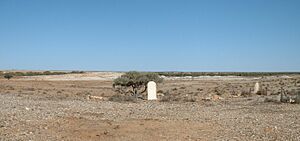Albert Goldfield facts for kids
Imagine a time when people rushed to find gold! The Albert Goldfield was a huge area in the outback of New South Wales, Australia. It covered about 1300 square kilometres (500 square miles). Gold was first found here in 1880. This exciting discovery happened at a place called Mount Browne, which is about 53 kilometres (33 miles) southwest of Tibooburra. Other places where gold was found included Good Friday, Easter Monday, Nuggerty, Pioneer Reef, and Warratta Creek.
Contents
The Albert Goldfield: A Gold Rush Story
The Albert Goldfield was a very important place in Australian history. It shows how people lived and worked during the exciting gold rush times.
Discovering Gold in the Outback
Gold was found in 1880 in a very hot and dry part of Australia. This area is known as the outback, which is far away from big cities and towns. Because water was so hard to find, new towns like Milparinka and Tibooburra grew up where there was enough water. Other towns, like Albert and Mount Browne, did not last long because they ran out of water.
By 1881, more than 2000 people had moved to the goldfields. They were either digging for gold or living in the nearby towns. A geologist named William Henry John Slee was put in charge of the goldfield. He was called the Goldfield Warden.
Life on the Goldfields: A Tough Challenge
Life for the gold miners was very hard. Water was scarce, meaning there was not much of it. Miners had two main ways to find gold:
- They could take their dirt to towns where water was available. There, they would use water to "pan" for gold. Panning involves swirling water and dirt in a pan to separate the heavy gold from the lighter dirt.
- They could use a method called "dry blowing." This meant breaking the dirt into very fine pieces. Then, they would let the wind blow away the lighter dirt, leaving the heavier gold behind.
Fresh food like fruits and vegetables was almost impossible to find. Basic supplies, such as flour, were very expensive. People often got sick because of the tough conditions. Diseases like dysentery and typhoid were common. These illnesses made life even harder for the miners and their families.
The End of the Gold Rush
By 1893, the exciting gold rush at Albert Goldfield had mostly ended. Most people had left the area to find gold elsewhere or to return to easier lives. The Albert Goldfield became a quiet place again, but its story remains an important part of Australia's history.


